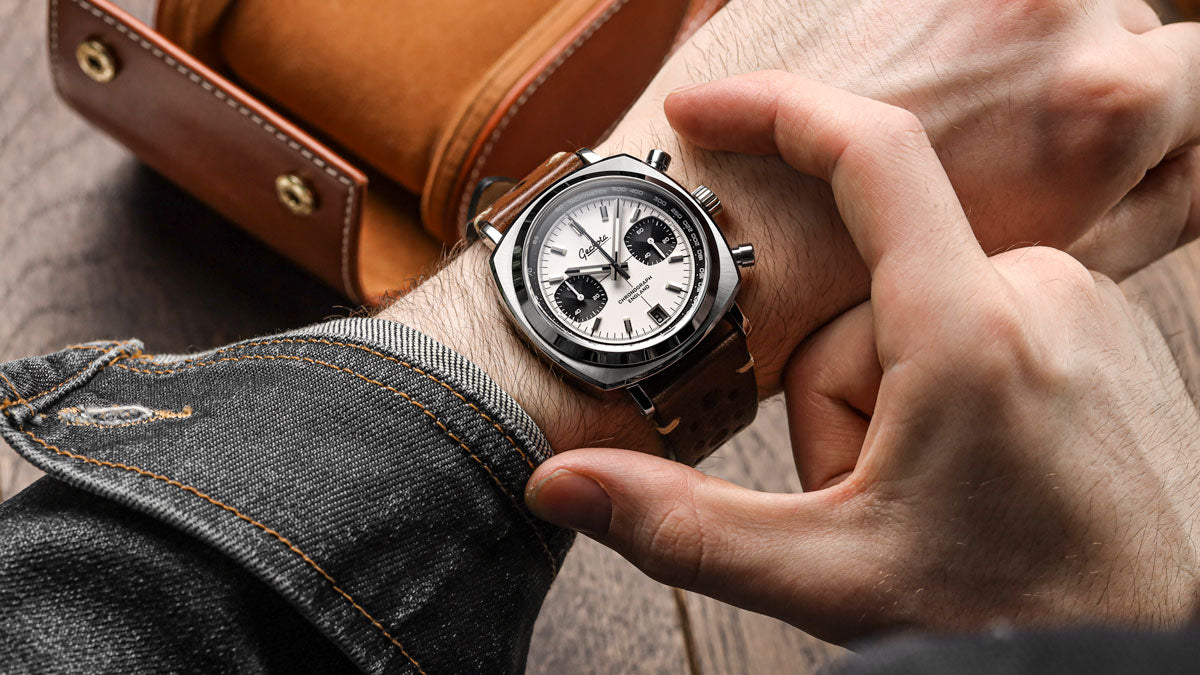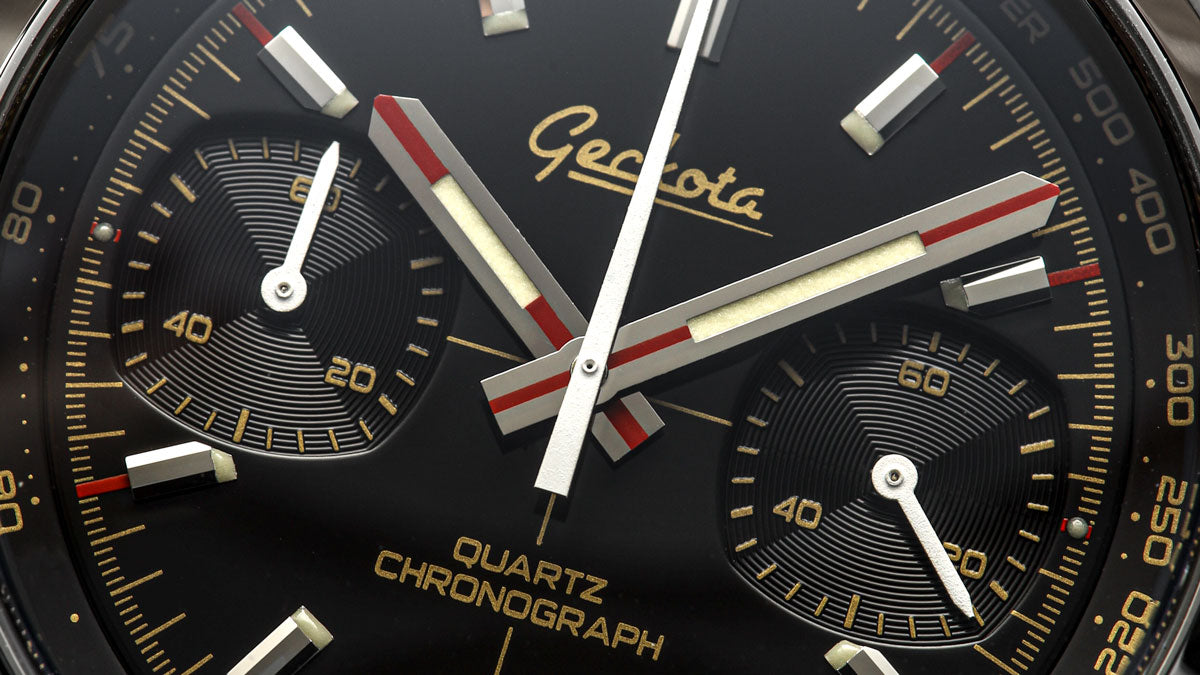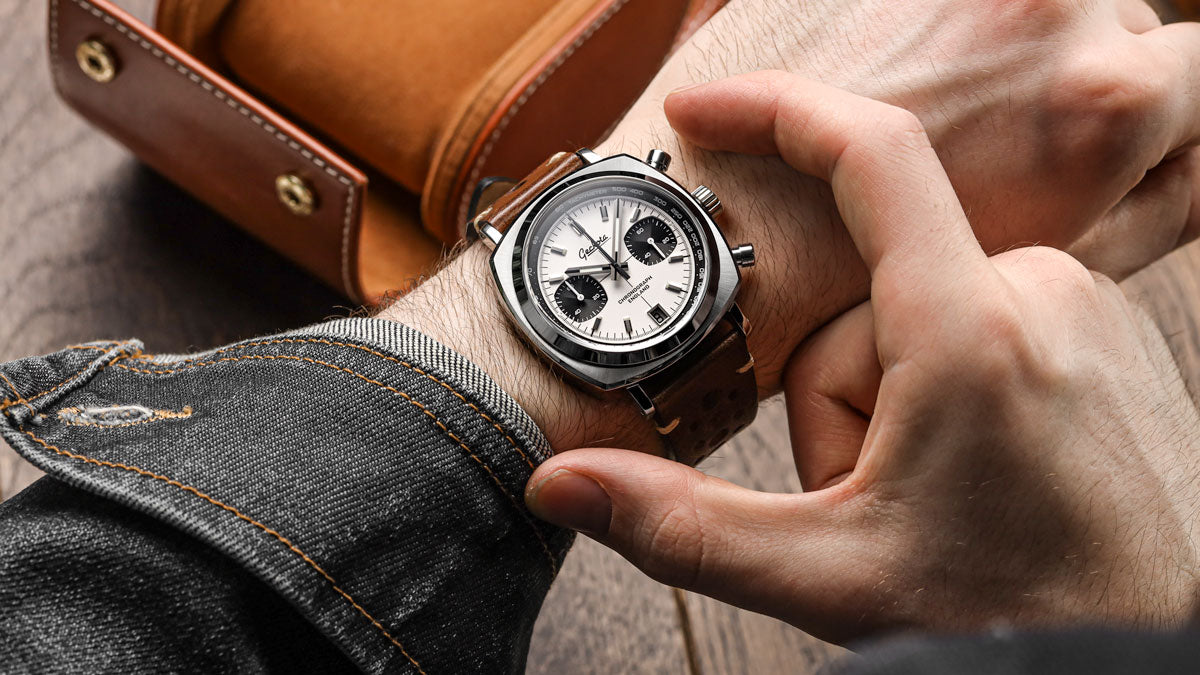
September 11, 2023 4 min read
One of the most popular, more complex watches is the chronograph. A stopwatch for the wrist, the chronograph has captivated enthusiasts and collectors for over two centuries, delighting with its multiple subsidiary dials and push pieces. But how exactly does the chronograph work? And how do you use a chronograph? Today, we’re journeying through the fascinating world of chronograph watches and demystifying their complex mechanisms, so you can finally wear yours with confidence.
 Geckota Chronotimer Chronograph - Credit Geckota
Geckota Chronotimer Chronograph - Credit Geckota
The origin of the chronograph watch was a subject of debate not all that long ago. Until 2012, it was well known that the world’s first chronograph watch was engineered by a French watchmaker called Nicolas Rieussec. He was commissioned by Louis XVIII in 1821 to make a device for timing horses. Known as an ‘inking chronograph’, the ingenious device utilised an ink-tipped nib that would drop ink onto two rotating counters, one for the minutes and the other for the seconds. The user would have to simple push the nib every time a horse crossed the finish line to mark its finish time.
For almost two centuries, Nicolas Rieussec’s invention was credited as the world’s first chronograph until the year 2012, when at a Christies watch auction, another chronograph came to light, one six years older. It seems another French watchmaker named Louis Moinet created a pocket stopwatch in 1815 to help make astronomical observations. Considering it was the first of its kind, the chronograph was impressive, running at a speed of 216,000 vibrations per hour and measuring recorded time to 1/60th of a second.
As for the world’s first chronograph wristwatch, that gold medal goes to Longines who developed their Calibre 13.33Z in 1913. It was widely known as a ‘doctors watch’ since it was paired with pulsometer dials which allowed medical personnel to start the chronograph and measure a patient’s pulse. Two years later, Breitling released their first chronograph watch with an independent push piece and from that moment on, luxury watch brands all around the world began to follow suit.
 Geckota Chronotimer Chronograph - Credit Geckota
Geckota Chronotimer Chronograph - Credit Geckota
The term ‘chronograph’ literally means ‘time recorder’ and labels watches that allow you to measure periods of time, just like a stopwatch. They regularly have three central hands for the standard hours and minutes plus an additional hand for the chronograph seconds. Then, there is typically two or three “subsidiary” dials – by “subsidiary” we mean those smaller dial-like counters placed within the main dial. One is for the running seconds, and the other two are usually for the chronograph’s 30 minute and 12 hour counters.
Using a chronograph watch is super simple once you know how to do it, but don’t’ worry, we’ve all felt overwhelmed using our first chronograph watch. There feels like there’s so many counters and pushers to make use of, it’s understandable not to know where to start.
On the right hand side of the case, you will find two push pieces – one at 2 o’clock and another at 4 o’clock. The former 2 o’clock pusher is used to start and stop the chronograph function, the latter 4 o’clock pusher resets the entire complication back to zero.
When you press the 2 o’clock pusher, the central chronograph seconds hand will begin measuring elapsed seconds. Once this does one full turn of the dial, you’ll notice the minutes counter change to indicate the elapsed minute. If you keep the chronograph running for multiple hours, this will be displayed on the hours counter. Most chronograph watches allow you to measure elapsed time for up to 12 hours. To stop the chronograph, simply press the 2 o’clock pusher again. This will freeze all the counters in place. To reset the chronograph back to zero, press the 4 o’clock pusher.
 Geckota Chronotimer Chronograph - Credit Geckota
Geckota Chronotimer Chronograph - Credit Geckota
Truth be told, most people buy and wear chronograph watches simply because they look cool. With their protruding pushers and contrasting subsidiary dials, chronograph watches have a distinctively sporty look which many watch wearers enjoy. The chronograph complication, when not used seriously, can be a really fun feature to play around with, whether you’re just showing off the moving hands to your mate or timing how long it takes for food to cook.
There are some people that need a chronograph watch for more meaningful occasions, however. For example, chronograph complication can be essential for pilots or motorsport enthusiasts making speed and distance calculations. Health workers can also use chronograph watches with pulsometers scales to measure patients heart beats.
 Geckota Chronotimer Chronograph - Credit Geckota
Geckota Chronotimer Chronograph - Credit Geckota
Everything we’ve detailed in this feature so far applies to your classic “simple” chronograph. These are the most common chronograph watches you’ll find. Nevertheless, there are some other, more complex types of chronograph watches too called the flyback chronograph and the Rattrapante chronograph.
The flyback chronograph is a more advanced version of the simple chronograph which allows you to rapidly restart the timer while the chronograph is still running. Rather than having to stop the chronograph with the 2 o’clcok pusher first, you can instantly reset it with the 4 o’clock pusher and all the chronograph hands will “fly” back to zero for restart. A flyback chronograph is particularly useful for those that need split second accuracy.
An even more complex chronograph watch is the Rattrapante chronograph, also sometimes referred to as a split seconds chronograph. In this instance, the watch has two central chronograph seconds hands, one superimposed beneath the other. There’s also a third chronograph pusher. When you press the 2 o’clock pusher like normal, both central seconds hand begin to spin around the dial. You stop the first by pressing the 2 o’clock pusher, and the second by pressing the third pusher – typically at 10 o’clock. This allows the wearer to record multiple time intervals that start at the same time but do not end together.
 Geckota Chronotimer Chronograph - Credit Geckota
Geckota Chronotimer Chronograph - Credit Geckota
So there you have it, all you need to know about the chronograph watch. Has this tempted you to buy a chronograph for yourself? Or do you already own one? If so, let us know what your favourite chronograph watch is down in the comments below.

About the Author: Jon Quinn
About the Author: Jon Quinn
I’m Jonathan Quinn, founder and owner of Geckota. What excites me is what excited me when I started the business – offering high-quality watches and straps that I couldn’t find elsewhere, and seeing the pleasure they give our customers around the world.
More Articles by Jon Quinn